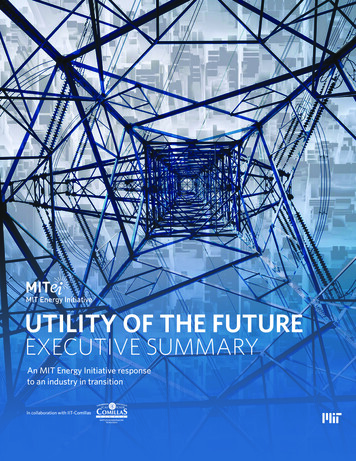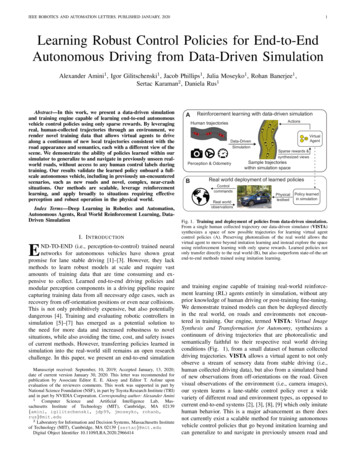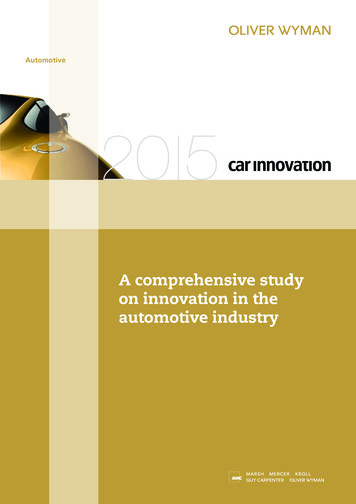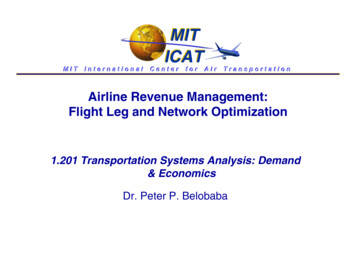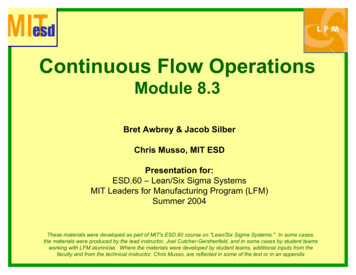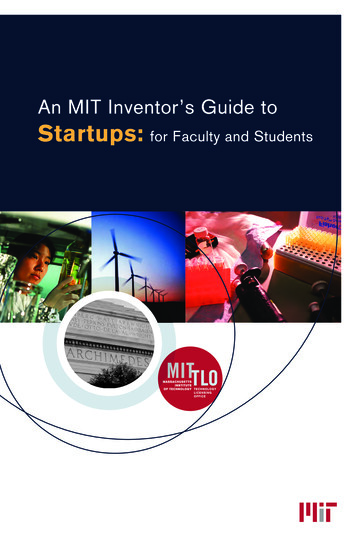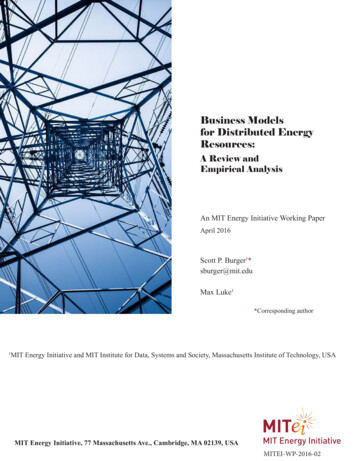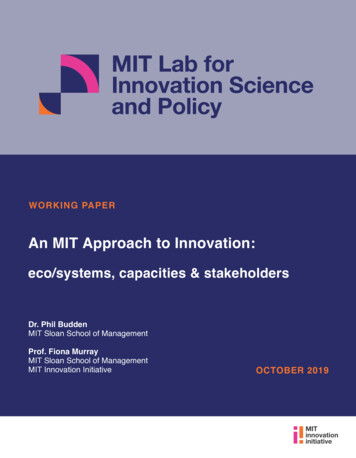
Transcription
WORKING PAPERAn MIT Approach to Innovation:eco/systems, capacities & stakeholdersDr. Phil BuddenMIT Sloan School of ManagementProf. Fiona MurrayMIT Sloan School of ManagementMIT Innovation InitiativeOCTOBER 2019
An MIT Approach to Innovation:eco/systems, capacities & stakeholdersDr. Phil BuddenMIT Sloan School of ManagementProf. Fiona MurrayMIT Sloan School of ManagementMIT Innovation InitiativeWorking PaperOctober 2019Published by MIT’s Laboratory for Innovation Science & Policy
MIT approach to ‘innovation’: eco/systems, capacities and stakeholdersInnovation can mean many things to many people, and no-one has a monopoly: as such, it risksbecoming a buzzword, surrounded by others, but it is in fact a key phenomenon. Below we setout the key elements of the MIT definition and approach. From this understanding flows ouranalysis of the process and how a state’s various innovation units and agencies operate in thewider national innovation system in which they exist and engage the external ecosystem(s).Innovation: a definition and a spectrumMIT’s systematic study of ‘innovation’ around the world – including in the national security andpublic safety fields – has resulted in three key and connected concepts: eco/systems, capacitiesand stakeholders. These build on the definition of ‘innovation’ from MIT’s Innovation Initiative(MITii) simply as the: “process of taking ideas from inception to impact”. (Interestingly, MITdoes not include the word ‘technology’ as innovation is something else, even if it harnesses it.)By taking a ‘process’ definition of innovation, with a trajectory from ‘inception’ all the waythrough to ‘impact’, this goes beyond a single moment of invention: it is then possible to look atthe distribution of the underlying activities, assess key determinants and define the role of arange of individuals, teams and organisations (both private and public sector enterprises). Inthis context, an ‘idea’ is a match (initially hypothetical) between a problem and a solution, with‘impact’ going beyond commercial profits (in the private sector), to include a variety of otheroutcomes, such as environmental, social, medical or security missions (in other sectors).In much common discourse on innovation, we find at least two distinct types of activities thatare often raised, but need to be more clearly distinguished: these can be regarded as being on aspectrum, and best placed within a ‘problem/solution’ matrix.First, there is formal ‘Innovation’ (with a capital “I”) meaning either the processes of takingnovel S&T research and development (R&D) outputs (usually novel technological solutions toexisting problems), or transformational innovations (matching novel solutions to novelproblems), from inception through to impact: such impact is often described as being out onthe frontier (or 'horizon 3') in the ‘10x’ transformation category.Second, there is a more modest form of innovation which covers the innovative adoption oradaptation of existing technologies, practices and resulting capabilities, ie innovation with alittle “i” which would fall into more of a ‘10%’ category: this signifies a more widely applicableset of innovative behaviours seen in private (but now also in many public) sector actors.Copyright MIT: Phil Budden & Fiona MurrayMIT approach to innovation
Along a continuum from little “i” to big “I” innovation are of course a range of activities, withmany commonalities in terms of the process being undertaken, but also with considerabledifferences in time scale and aspiration. Below, our graphic plots the novelty of ‘Problems’against ‘Solutions’ to create an innovation landscape.Much formal S&T/R&D ‘Innovation’ is out along the x-axis, reaching out to low Tech ReadinessLevels (TRLs) where an enterprise is looking to invent entirely new solutions to its existingproblems (often in the 10x transformation range). A more dramatic vector of innovation is theone where an enterprise (often a start-up) aims to create big “I” solutions to entirely newproblems: the level of risk here is higher given that both the problem and the solution have ahigher degree of novelty. As such, this is often a difficult space for established enterprises.As this graphic makes clear, there is another two-way vector of innovation, namely that oflinking existing solutions to new problems. For a solution-owner, this can mean applying itsexisting innovation to new sectors or new problems. For a problem-owner, this can meanscouting that innovation frontier (or scanning that horizon) for existing solutions whose ownermight regard that problem as being novel. Such innovation can occur here when such novel‘solution/problem’ matches from other sectors and actors in the ecosystem are brought intoyour organisation, often on a much shorter timeline than traditional S&T/R&D efforts.Of course, along all three of these vectors, the more informal ‘little i’ innovation is closer to (butstill a step beyond) ‘business as usual’ (BAU) which itself includes incremental improvement.Such ‘little i’ innovation is a more modest but still honourable form of innovation (say in the2
10% range) but draws on similar techniques as those for achieving ‘big I’, even if matching onlyslightly more novel problems and solutions together.These different types of innovation are linked, exist along a spectrum (rather than beingentirely distinctive) and are indeed supportive of one another. The successful organisations arethe ones that recognize the differences between formal ‘Innovation’ and the more modest setof ‘innovative’ projects, and explores both in a portfolio approach. They also recognize thatsimilar ‘agile’ practices and other organisational changes can serve both: this needs not only tobe reflected in changes of staff behaviour and organisational culture, but also in the role playedby senior leadership to enable such innovation to flourish. Simply adopting new technologies(from R&D or outside) will not deliver the expected ‘return on investment’ (ROI) if they are notaccompanied by changes to individuals’ behaviour, institutions’ leadership and resultingincentive structures – with all becoming more agile and adaptive.Indeed, many of the insights about ‘innovative’ behaviour, capabilities and culture are informedby MIT research into the practices behind world-class ‘Innovation’ organisations (including bothR&D-intensive corporations, but also high-growth start-ups) whose effective deployment oftalent and risk capital, and openness to experimentation towards specific problem/solutionmatches are essential to their impact.Innovation: eco-systemsInnovation is not evenly distributed by whatever proxy measurement one chooses to assess it.Common measures include patenting, for example, as well as the scale of ‘venture capital’(VC) deployed, though the latter probably understates the innovation in countries lessdependent on open market systems. Regardless of the measure used, trends show thatinnovation tends to be most focused in geographically-bounded hubs which are characterisednot only by dense concentrations of resources and capacities to support innovation but also anetwork of human agents and organisations facilitating rapid resource exchange and circulationto create an ‘eco-system’ of interdependent entities.3
For any such geographical region (such as a nation/state), MIT has developed a systematic wayto examine and assess how that region experiences and delivers ‘innovation’ (see the diagrambelow), allowing for some global comparison (at least with country-level data). This matters toour understanding of the ability of the public sector to deliver on innovation’ because decisionsabout any state’s system of agencies which it establishes to accelerate such innovation(whether for civilian, security or dual purposes) will be informed by this understanding of whereand why innovation thrives in certain ecosystems.In the MIT model, the core elements to such innovation are – at the base – foundations andinstitutions (e.g. rule of law) upon which much else rests. Above that are two distinct capacities– ie Innovation Capacity (I-Cap) and Entrepreneurial Capacity (E-Cap) – which are exploredfurther below. In many regions and nations, the innovation economy is specialised around keyactivities of ‘comparative advantage’ (that may be defined in terms of sectors, technologies orassets). The ‘impact’ of these elements can be measured in a variety of ways (e.g. economic,social, security, etc) – hence our use of the term to allow for context-specific choices.Innovation: state systemsTo achieve innovation across the landscape outlined above, governments have established theirown ‘systems’ of state agencies, units and departments each of which is focused on innovationin its own particular sector or mission (as well as agencies and units designed to support big “I”innovation across a wider set of domains): this is equally true for public safety and nationalsecurity as it is for health or transportation.1 As such, it is important that the review of anyspecific state agency, unit or department – and its mission and impact – should consider thestate ‘system’ and the also the wider ‘eco-system’ in which it is embedded, and therefore thespecific role it should play in order to have the appropriate impact and anticipated added value.1Our recently published MIT Working Paper applies this methodology to the ‘defence innovation’ field, wherestates have a range of units, eg in the US from defence S&T labs through to DARPA itself as well as the morerecently formed Defense Innovation Unit (DIU): on-Report.pdf4
Such a system is itself not static, so the division of responsibilities among constituent parts willevolve and need to be re-designed, as their different operating models deliver impact ondifferent time scales, and in different parts of the innovation landscape. A key insight fromreviewing other states’ evolving systems and changes to the innovation agencies within them isthat this reform effort can often be viewed as a form of ‘system experimentation’ in its ownright, with efforts to unlock greater ‘innovative’ behaviours and better ‘Innovation’ outcomesby adjusting and adding to the system, and the way it engages the wider eco-system.In our system approach, the capability to ‘innovate/experiment for innovation’ is a key one –enabling the system (including for national security or public safety) and its constituentgovernmental parts to create new models that at once reflect and engage with each other, butalso with the evolving wider economy and the external ecosystem’s stakeholders.Such external ecosystem awareness is driving current security agency interest in so-called ‘dualuse’ technologies, especially those pioneered in the private sector.2 This is a particular focus(e.g. in the US), as the civilian economy outpaces that for national security in technologicalsophistication in key domains (especially digital) and in new enterprises (particularly new startups and ventures).Innovation: an eco-system’s two CapacitiesReturning to MIT’s model, there are two distinct Capacities, which provide the ‘twin engines’ ofinnovation. The first, Innovation Capacity (I-Cap), is the one most associated with traditionalinputs, such as spending on research and development (R&D) or science and technology (S&T).While these are important and necessary inputs, they are not sufficient in explaining the rangeof innovation ‘impact’ outcomes that various countries achieve, including in the security space.Indeed, these are inputs principally for the Funding part on the I-Cap side, and there are avariety of other categories of inputs which will also be of importance to getting a return on thatR&D investment. In short, it is not enough simply to ramp up spending on R&D (or S&T) andexpect the desired innovation impacts.The second Capacity is that related to Entrepreneurship (E-Cap). In some countries, the rulesaround the economy are optimised to encourage enterprise-formation (eg start-ups) and their2The term ‘dual-use’ has its origins in the early Cold War, especially related to nuclear technologies which couldhave both military/weapon and civilian/industrial applications. In today’s more digital phase of industrialization,the familiar ‘dual-use’ term needs to be viewed through the increasing imbalance between rapidly acceleratingcivilian capabilities and the much more limited governmental/military ones. As such, the balance of ‘dual-use’ hasswung decidedly away from solely sovereign capabilities.5
growth (eg scale-up) and expansion (eg through export promotion). These inputs clearly gobeyond just the Funding aspect of E-Cap (such as ‘risk capital’, including formal Venture Capital(VC) firms), and also harness other aspects, such as existing Human Capital with a propensityand the incentives to be entrepreneurial. By itself, a strong Entrepreneurial Capacity (E-Cap)should lead to more enterprises, but many of these will be of the ‘small and medium-sizedenterprise’ (SME) variety, rather than the high-growth, high-potential ones which harnessinnovation from the I-Cap side, and are likely to become – in MIT’s parlance – ‘innovationdriven enterprises’ (IDEs) instead.The two Capacities – I-Cap and E-Cap – are represented in this simple design above: innovationecosystems do best when the two interact, leading to ‘innovation-driven entrepreneurship’,with start-ups that are more likely to become ‘innovation-driven enterprises’. For eachCapacity, there are 5 categories of inputs which go beyond just Funding – such as the standardR&D (or S&T) spend on the I-Cap side, or formal entrepreneurial ‘risk capital’ input (such as VCfunding) on the E-Cap side – to cover a much wider set of metrics.3Innovation: stakeholdersLastly, the more successful ‘innovation ecosystems’ have active engagement from five keystakeholder groups, where each has a role to play. This model goes beyond the traditional‘dyad’ of big ‘public-private’, Government-Corporate or ‘military-industrial complex’ relations,and even beyond the popular ‘triple helix’ which simply added the ‘entrepreneurial’ University.3For a deeper dive into this ‘science of innovation’ approach and emerging ways to measure the various Inputs byCategory, our recent Working Paper is an early systematic attempt to assess and compare these ing-iEcosystems-V2-Final.pdf6
Instead, to understand today’s innovation and its eco-systems, MIT regards it as important toinclude both the entrepreneurial community (creating the enterprises of the future), and the‘risk capital’ providers (who assess and fund these new ventures). As such, this goes beyondjust developing the ‘entrepreneurial university’ (of which MIT was Etzkowitz’s archetype4), andadds these two additional stakeholders, as represented in the MIT diagram below:Within innovation ecosystems, most stakeholders will have their own formal arrangements andsystems for driving innovation. In the case of a Government, it will have a formal (and more orless rational) state ‘system’ of units and agencies which is designed to deliver innovation (eg forsecurity/safety) and engage with a larger and more organic ‘ecosystem’ of non-state actors.MIT approach to innovation for national security/public safetyMIT’s systematic study of ‘innovation’ around the world and in a variety of sectors has resultedin three key and connected concepts (eco/systems, capacities and stakeholders) which all haveapplicability to the five stakeholders, and especially Government, even in the national securityand public safety fields. Given the evolving nature and pace of innovation (often enabled bydigital technologies, e.g. the latest waves of artificial intelligence (AI) and machine learning(ML)) and its concentration in certain ecosystems, however, many of the leading and most agileactors may be stakeholders other than Government (or indeed large Corporate) enterprises.This phase of innovation creates challenges for Governments and the systems of stateagencies. First, they are no longer at the ‘frontier’ of all key technologies and may have lessvisibility into horizon 3.4Etzkowitz, H., and Leydesdorff, L. (1995). ‘The Triple Helix: university–industry–government relations’, EASSTReview, Vol 14, pp 14–19. Etzkowitz, H. (2002), MIT and the Rise of Entrepreneurial Science, Routledge, London.7
In earlier decades of inter-state competition (for example in the twentieth century Cold War),governments and their prime contractors (large Corporates) were clearly at the cutting edge ofdelivering security innovation. Whether it was for radar, rocketry or nuclear technology, themilitary-industrial ‘dyad’ was in the lead, and the barriers to entry in such security innovationwere sufficiently high to keep most non-state actors out of such efforts.Since the end of that Cold War, however, government actors have no longer had a monopolyon such innovation (especially in the expanding digital realm) to solve the challenges of a nationespecially in regard to its safety and security missions. Increasingly, formal agencies in a statesystem have to look beyond themselves - and beyond even their traditional prime contractors,or their allied states, creating a ‘system of systems’ with their efforts at state innovation – tothe external ecosystems in which they operate, and the other stakeholders in those ecosystemsto meet the state’s security and other innovation goals.Second, many states find that their ‘system’ of agencies and units for innovation is no longeroptimally fit for service: moreover, instead of being the result of a design-led approach, thesystem had more often than not evolved over time, with some rational additions, but also therisk of duplication, mission-creep and other bureaucratic challenges. While the end of the ColdWar allowed for some re-purposing and rationalization, many states’ systems have not had aformal re-organisation for the new phase into which they are entering. States that have beenamong the most reforming and innovative are also among the most revisionist adversaries.Lastly, a simple re-organisation of the state’s system for security innovation will not be enough.With the need to link to a range of distinctive ecosystem actors – not simply well-established,prime Corporate contractors – there is a premium on security agencies becoming innovativeinternally, being effective not only at familiar big “I” vectors (such as from internal R&D/S&T),but also in how they seek to harness solutions from a range of external stakeholders across theinnovation landscape. A traditional organisation is likely find it challenging to engage with lessfamiliar entrepreneurs and their start-ups, or to scout and effectively harness new solutions outon the innovation frontier, no matter their ‘horizon-scanning’ in non-traditional sectors.To meet these challenges, governments also need to encourage a more ‘innovative culture’and/or ‘agile behaviour’ in its state agencies and their system. Internally, the agencies in thesystem need to evolve so as to be able to better engage the wider ecosystem of stakeholders(especially entrepreneurs and ‘risk capital’ providers) rather than just their establishedsuppliers of traditional R&D/S&T ‘Innovation’. The latter also need to be more ‘innovative’ and‘agile’ in the way they commission, fund and deliver their own ‘Innovation’ for the agencies.8
ConclusionsWith the system itself, the Government and its agencies need to consider the division of labourwithin and among the various constituent parts: a system that simply evolved may no longer beoptimally fit for service today, requiring changes both within existing units and also among theirroles and responsibilities. This is further complicated by the need for the state system ofagencies to be configured so as to best engage with the wider ecosystem. It will be hard for thenon-state innovators to support the Government if its own agencies do not have a clear, sharedunderstanding of their division of labour, and who is best placed to engage whom on what.The ways in which different agencies engage with their broader innovation ecosystems is alsodependent not only on internal goals and existing capabilities but also on the nature of thelocal ecosystem itself. For example, the United States has multiple regional innovationecosystems (as seen in the earlier VC map ), characterized by several core locations – e.g.Silicon Valley, Boston, New York, Austin, etc. It also has significant depth in institutionalisedventure capital (VC) and other related forms of ‘risk capital’ that enable rapid rates of start-upformation and scale-up growth across a wide range of sectors. In contrast, the UK has a smallerset of innovation ecosystems (largely based in London and the wider Golden Triangle) and withmore highly specialized areas of expertise and comparative advantage in areas including AI.Consideration of other state’s efforts is useful up to a point, but the interaction of agencies in astate system, and then their engagement with the nation’s local ecosystems, are sufficientlycomplicated so as to deny easy answers. Simply replicating one state’s system or a specific unit(eg DARPA) without understanding how this was designed to engage its specific ecosystems (egSilicon Valley and Boston) and other active stakeholders (eg US VCs or research universities)available to it would lead to a disappointingly sub-optimal innovation outcome. Instead,optimising for country-specific innovation goals as well as for ecosystem-specific strengths andweaknesses is a crucial part of a wider innovation strategy for any government agency intenton maintaining a strong process to deliver solutions to existing and emerging challenges.All this is a challenge for state systems of innovation, which may have traditionally been moreinward-looking, content to work with the usual suspects or relying on other states for thedevelopment of capabilities: now they must be designed to leverage private sector start-upgrowth with programmes that re-orient engagement with the ecosystems accordingly. Manystates are now experimenting to find the best way to keep up, both with fast-movingtechnologies and less-hindered adversaries.9
An MIT Approach to Innovation: eco/systems, capacities & stakeholders . MIT does not include the word ‘technology’ as innovation is something else, even if it harnesses it.) . it is important that the review of any specific state agency, unit or departme


